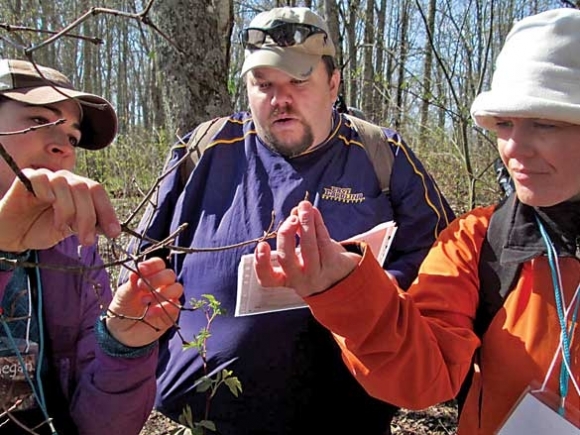Comprehending climate: Smokies seeks to understand impacts of shifts in seasonal patterns

According to the National Phenology Network, Punxsutawny Phil had it all wrong when he emerged from his hole this month to declare six more weeks of winter — across the Southeastern U.S, the NPN’s data shows, spring 2017 is arriving three weeks earlier than the 1981-2010 average.
The Great Smoky Mountains National Park is looking for volunteers to help gather the data that will bring such generalizations down to a more local level. Phenology — the ways that plants and animals respond to seasonal changes — has been the subject of increasing interest as discussions about climate change have heated up, and the park is now four years into a volunteer program to collect data for the larger NPN project.
Basically, each volunteer is assigned a plot of trees, which they visit once a month to spend 15 minutes or so taking data on trees in the plot. For example, does the tree have leaves, and if so about what percentage of its leaves are out? Are they changing color yet? Is fruit present?
“Trees are a really good indicator, because if it’s getting warm and staying warm, they will start to bloom earlier than in recent springs,” said Natalie Rothenberg, an AmeriCorps member working on the project. “Conversely, if it stays warm in the fall, the leaves will change later in the season.”
Pieces of a puzzle
Trees aren’t the only indicators that Smokies scientists are considering to quantify seasonal shift. They’re looking at everything from wildflowers to birds to insects. But when it comes to trees, volunteers get a chance to help out the professional scientists. Each year, a training session gives science novices all the information they need to generate data that can be plugged into the NPN’s nationwide database.
Related Items
The idea, said Smokies education coordinator Susan Sachs, is to not only understand whether and how the seasons are changing but how those changes affect the ecosystem as a whole.
For example, does an early spring mean that an early fall is likely? Does an early spring in the Southeast usually correlate with an early spring further north? If birds time their migration based on length of day rather than temperature, how will warmer temperatures during migration season affect their food sources?
“What does that mean for insects, and what does that mean for birds who eat those insects?” Sachs said. “If the birds aren’t there yet, does that mean we’ll have a boom of insects?”
There’s also the question of how an earlier leafout can affect the wildlife species that feed on fruits and nuts.
“It’s a phenomenon we like to call summer in March, winter in May,” Sachs said.
When leafout happens early, she said, trees might be well into growing fruit by the time May rolls around. But at that stage of development, a hard freeze — something that’s not unusual for May in the Smokies — can spell disaster for fruit production.
“You loose your berry and your nut crop, so when it comes to fall bears don’t have enough to eat, and they come down into people’s yards,” Sachs said. “We’ve been seeing a pattern of that happening more. We want to know for sure, is this our imaginations?”
The more data the park has, the more conclusions it can draw. By looking at tree data together with data on insects, wildflowers and other organisms, scientists can get a better idea of how all these facets of park life adjust and interact when climate shifts.
A better understanding of seasonal changes is also important when it comes to working with visitors. The Smokies is the most-visited national park in the country, logging more than 11 million visits last year. Many of those visits are related to season-dependent attractions, like wildflowers and fall colors. One of the most in-demand visitor programs of the year is the two-week synchronous firefly viewing at Elkmont, a phenomenon whose timing can shift depending on the weather. The event is so popular that the park has to arrange a shuttle system to ferry people from Gatlinburg, so it’s important to plan ahead.
“We have to arrange that before we know when they’re going to come out,” Sachs said. “It’s kind of temperature-driven. So if we can see some patterns in when spring is arriving, it helps us do a better job of managing some of our visitor programs.”
A new pattern?
This will be the Smokies’ fourth year of NPN data collection, with some of the pilot sites at the Tremont Institute now in their sixth year. That’s not a long enough collection period to draw any firm trends, though what’s been gathered so far seems to indicate that springs are longer and warmer than they’ve been in the past. In the Smokies, “the past” goes back a pretty good distance, with weather data on file from 150 years ago.
“You definitely see patterns and fluctuations, but what appears to be happening is in the past 20 years in particular it looks like there might be a new pattern forming,” Sachs said. “It looks like a new pattern, but we don’t have enough data yet to say for sure.”
Five to seven years from now, though, the data set will be large enough to draw some pretty solid conclusions, and thanks to volunteer efforts Sachs expects the Smokies’ data to be some of the most robust in the NPN database.
“The more data you get, the more likely it is the story that’s shaping up is valid,” she said. “Individual people may make mistakes, but if there’s enough data, that noise gets canceled out. The data that has been coming from the Smokies in that National Phenology Network map is, to be honest, among some of the clearest data because there’s so much of it.”
Become a citizen scientist
Volunteers are needed to help the Great Smoky Mountains National Park amplify its data on how seasons are shifting in the park, with a training session scheduled for 9:30 a.m. to 12:30 p.m. Saturday, March 11, at the Oconaluftee Visitor Center near Cherokee.
Each volunteer will adopt one of 28 tree-monitoring plots scattered throughout the park, visiting the plot about once per month throughout the growing season to collect data such as when trees leaf out, when they start to change colors or when migratory birds appear in their branches. All plots are located near parking areas, with a roughly even number on the Tennessee and North Carolina sides of the park.
Last year, about 80 people collected data, with multiple people assigned to each plot to decrease the burden on individual volunteers. However, more volunteers are always needed.
“We can never get too much data,” said Susan Sachs, education coordinator for the park. “Especially in the spring and the fall, if we have people doing data collection in the same day, there’s a difference between data collected in the morning in the spring and in the evening. You will actually see things happen that quickly.”
The schedule is flexible, and no expertise is necessary to join. All data goes into a nationwide database managed by the National Phenology Network.
Sign up for the training with Natalie Rothenberg, This email address is being protected from spambots. You need JavaScript enabled to view it. or 828.497.1945.
Contribute to NASA
You don’t have to go to the Great Smoky Mountains National Park to help gather data about climatological changes.
A training for NASA’s Global Learning and Observations to Benefit the Environment — an international science and education program that gives people a chance to participate in the scientific process through weather data collection — will be held noon to 1 p.m. Friday, Feb. 24, at the Macon County Public Library in Franklin.
The Macon Early College Environmental Science Club will lead the workshop, teaching participants how to become effective GLOBE citizen scientists. GLOBE data collection kits will be available for checkout from the library following the program.
www.globescistarter.org. 828.524.3600.









